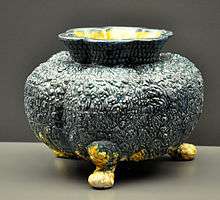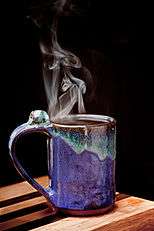Ceramic glaze
Ceramic glaze is an impervious layer or coating of a vitreous substance which has been fused to a ceramic body through firing. Glaze can serve to color, decorate or waterproof an item.[1]
Use
Glazing renders earthenware vessels suitable for holding liquids, sealing the inherent porosity of terracotta. Glaze is also used on stoneware and porcelain. In addition to their functional aspect, glazes can form a variety of surface finishes, including degrees of glossy or matte finish and color. Glazes may also enhance the underlying design or texture either unmodified or inscribed, carved or painted.
Glaze is used to weatherproof brick or tile building materials. The Iron Pagoda, built in 1049 in Kaifeng, China, of glazed bricks is an example.[2]
Composition
Raw materials of ceramic glazes generally include silica, which will be the main glass former. Various metal oxides, such as sodium, potassium and calcium, act as a flux to lower the melting temperature. Alumina, often derived from clay, stiffens the molten glaze to prevent it from running off the piece. Colorants, such as iron oxide, copper carbonate or cobalt carbonate, and sometimes opacifiers such as tin oxide or zirconium oxide, are used to modify the visual appearance of the fired glaze. Glaze for lead-glazed earthenware is transparent and glossy after firing.
Process

Glaze may be applied by dry-dusting a dry mixture over the surface of the clay body or by inserting salt or soda into the kiln at high temperatures to create an atmosphere rich in sodium vapor that interacts with the aluminium and silica oxides in the body to form and deposit glass, producing what is known as salt glaze pottery. Most commonly, glazes in aqueous suspension of various powdered minerals and metal oxides are applied by dipping pieces directly into the glaze. Other techniques include pouring the glaze over the piece, spraying it onto the piece with an airbrush or similar tool, or applying it directly with a brush or other tool.
To prevent the glazed article from sticking to the kiln during firing either a small part of the item is left unglazed, or supported on small refractory supports called kiln spurs which are removed and discarded after the firing. Small marks left by these spurs are sometimes visible on finished ware.
Decoration applied under the glaze on pottery is generally referred to as underglaze. Underglazes are applied to the surface of the pottery, which can be either raw, "greenware", or "biscuit"-fired (an initial firing of some articles before the glazing and re-firing).[3][4][5] A wet glaze—usually transparent—is applied over the decoration. The pigment fuses with the glaze, and appears to be underneath a layer of clear glaze. An example of underglaze decoration is the well-known "blue and white" porcelain famously produced in England, the Netherlands, China and Japan. The striking blue color is achieved by using cobalt in the form of either cobalt oxide or cobalt carbonate, both of which are still commonly used.[6]
Decoration applied on top of a layer of glaze is referred to as overglaze. Overglaze methods include applying one or more layers or coats of glaze on a piece of pottery or by applying a non-glaze substance such as enamel or metals (e.g., gold leaf) over the glaze.
Overglaze colors are low-temperature glazes that give ceramics a more decorative, glassy look. A piece is fired first, overglaze is applied, and it is fired again. Once the piece is fired and comes out of the kiln, its texture becomes smoother because of the glaze.
History

During the Kofun period of Japan, Sue ware was decorated with greenish natural ash glazes. From 552 to 794 AD, differently colored glazes were introduced. The three colored glazes of the Tang Dynasty were frequently used for a period, but were gradually phased out; the precise colors and compositions of the glazes have not been recovered. Natural ash glaze, however, was commonly used throughout the country.
In the 13th century, flower designs were painted with red, blue, green, yellow and black overglazes. Overglazes became very popular because of the particular look they gave ceramics.
From the eighth century, the use of glazed ceramics was prevalent in Islamic art and Islamic pottery, usually in the form of elaborate pottery.[7] Tin-opacified glazing was one of the earliest new technologies developed by the Islamic potters. The first Islamic opaque glazes can be found as blue-painted ware in Basra, dating to around the 8th century. Another significant contribution was the development of stoneware, originating from 9th century Iraq.[8] Other centers for innovative ceramic pottery in the Islamic world included Fustat (from 975 to 1075), Damascus (from 1100 to around 1600) and Tabriz (from 1470 to 1550).[9]
Environmental impact
As of 2012, over 650 ceramic manufacturing establishments were reported in the United States.[1] Floor tile, wall tile, sanitary-ware, bathroom accessories, kitchenware, and tableware are all potential ceramic-containing products that are available for consumers.[10] Heavy metals are dense metals used in glazes to produce a particular color or texture.[4] Glaze components are more likely to be leached into the environment when non-recycled ceramic products are exposed warm or acidic water.[11] Leaching of heavy metals occur when ceramic products are glazed incorrectly or damaged.[11] Lead and chromium are two heavy metals commonly used in ceramic glazes that are heavily monitored by government agencies due to their toxicity and ability to bioaccumulate.[11][12]
Metal oxide chemistry
Metals used in ceramic glazes are typically in the form of metal oxides.
Lead(II) oxide
Ceramic manufacturers primarily use lead(II) oxide (PbO) as a flux for its low melting range, wide firing range, low surface tension, high index of refraction, and resistance to devitrification.[13] Nitrogen dioxide (NO
2) plays a role in the mobilization of lead in the environment. In polluted environments, nitrogen dioxide reacts with water (H
2O) to produce nitrous acid (HNO
2) and nitric acid (HNO
3).[12]
H
2O + 2NO
2 → HNO
2 + HNO
3
Lead(II) nitrate (Pb(NO
3)
2) forms when lead(II) oxide (PbO) of leaded glazes is exposed to nitrogen dioxide (NO
2) found in polluted air.[7][12]
PbO + 2HNO
3 → Pb(NO
3)
2 + H
2O
The lead(II) nitrate product readily dissolves in water to form lead ions (Pb2+
) and nitrate ions (NO−
3):[12]
Pb(NO
3)
2 → Pb2+
+ 2NO−
3
When consumed, lead interferes with normal biochemistry by forming stable chemical bonds with amino acids of proteins.[14] When lead is converted to its stable oxidation state (Pb2+), it reacts with the sulphydryl groups (-SH) of cysteine.[13] Proteins bound to lead are unable to be used up by biological processes remain in the tissue of plants and animals.[13]

) and the sulfhydryl (–SH) groups on a protein.
Lead exposure is strongly linked to negative renal effects in animals and humans.[9] Renal deficiency was observed in Wistar rats after two weeks of orally ingesting lead acetate.[14]
Chromium(III) oxide
Chromium(III) oxide (Cr
2O
3) is used as a colorant in ceramic glazes. Chromium(III) oxide can undergo a reaction with calcium oxide (CaO) and atmospheric oxygen in temperatures reached by a kiln to produce calcium chromate (CaCrO
4). The oxidation reaction changes chromium from its +3 oxidation state to its +6 oxidation state.[15] Chromium(VI) is very soluble and the most mobile out of all the other stable forms of chromium.[16]
Cr
2O
3 + 2CaO + 3⁄2O
2 → CaCrO
4[15]
Chromium may enter water systems via industrial discharge. Chromium(VI) can enter the environment directly or oxidants present in soils can react with chromium(III) to produce chromium(VI). Plants have reduced amounts of chlorophyll when grown in the presence of chromium(VI).[16]
Prevention
Chromium oxidation during manufacturing processes can be reduced with the introduction of compounds that bind to calcium.[15] Ceramic industries are reluctant to use lead alternatives since leaded glazes provide products with a brilliant shine and smooth surface. The United States Environmental Protection Agency has experimented with a dual glaze, barium alternative to lead, but they were unsuccessful in achieving the same optical effect as leaded glazes.
Gallery
- ''Ceramic glaze''
-
Pottery, Nara period
-

Meissen porcelain, with blue underglaze decoration on porcelain
-

Mug with blue underglaze decoration on porcelain.
-
Test slabs of different glazes
-

20th century glazing technique
See also
Footnotes
- 1 2 Division, Company Statistics. "Statistics of U.S. Businesses Main Page". www.census.gov. Retrieved 2015-11-27.
- ↑ Daiheng, Gao (2002). Chinese Architecture -- The Lia, Song, Xi Xia and Jin Dynasties (English ed.). Yale University Press. pp. 166, 183. ISBN 0-300-09559-7.
- ↑ "Cleaning Biscuit Fired Ceramic Ware" Hulse D.K, Barnett W.C. UK Pat.Appl.GB2287643A
- 1 2 Denio, Allen A. (1980-04-01). "Chemistry for potters". Journal of Chemical Education 57 (4). doi:10.1021/ed057p272.
- ↑ "Roller Kilns For The Fast Biscuit And Glost Firing Of Porcelain" Rodriguez Mamolar M.J., De La Fuente Revuelta J. Ceram. Inf.(Spain) 20, No.202. 1994. Pg. 25–27
- ↑ 'Ceramics Glaze Technology.' J.R.Taylor & A.C.Bull. The Institute Of Ceramics & Pergamon Press. Oxford. 1986
- 1 2 Environment, Department of the. "Nitrogen dioxide (NO2)". www.environment.gov.au. Retrieved 2015-11-09.
- ↑ Mason (1995), p. 5
- 1 2 Missoun, F., M. Slimani, and A. Aoues. "Toxic Effect of Lead on Kidney Function in Rat Wistar." African Journal of Biochemistry Research 4.2 (2010): 21–27. Print.
- ↑ Environmental Protection Agency. (February 2003) Economic Impact Analysis of the Clay Ceramics Manufacturing NESHAP: Final Rule (EPA Publication No. EPA-452/R-03-007). Research Triangle Park, NC: Environmental Protection Agency.
- 1 2 3 Omolaoye, J.A,, A. Uzairu, and C.E. Gimba. "Heavy Metal Assessment of Some Ceramic Products Imported into Nigeria from China." Archives of Applied Science Research 2.5 (2010): 120-25. Web. 15 Oct. 2015
- 1 2 3 4 Baltrusaitis, Jonas; Chen, Haihan; Rubasinghege, Gayan; Grassian, Vicki H. (2012-12-04). "Heterogeneous Atmospheric Chemistry of Lead Oxide Particles with Nitrogen Dioxide Increases Lead Solubility: Environmental and Health Implications". Environmental Science & Technology 46 (23): 12806–12813. doi:10.1021/es3019572. ISSN 0013-936X. PMC 3518381. PMID 23057678.
- 1 2 3 Lehman, Richard. Lead Glazes for Ceramic Foodware. 1st ed. Research Triangle Park: International Lead Management Center, 2002.
- 1 2 Duruibe, J.O., M.O.C. Ogwuegbu, and J.N. Egwurugwu. "Heavy Metal Pollution and Human Biotoxic Effects." International Journal of Physical Sciences 2.5 (2007): 112-18.
- 1 2 3 Verbinnen, Bram; Billen, Pieter; Van Coninckxloo, Michiel; Vandecasteele, Carlo (2013-06-04). "Heating Temperature Dependence of Cr(III) Oxidation in the Presence of Alkali and Alkaline Earth Salts and Subsequent Cr(VI) Leaching Behavior". Environmental Science & Technology 47 (11): 5858–5863. doi:10.1021/es4001455. ISSN 0013-936X.
- 1 2 Oliveira, Helena (2012-05-20). "Chromium as an Environmental Pollutant: Insights on Induced Plant Toxicity". Journal of Botany 2012: 1–8. doi:10.1155/2012/375843.
References
- Hamer, Frank and Janet. The Potter's Dictionary of Materials and Techniques. A & C Black Publishers, Limited, London, England, Third Edition 1991. ISBN 0-8122-3112-0.
| ||||||||||||||||||||||||||||||
| ||||||||||||||||||||||||||||||
|